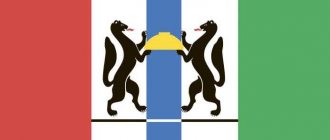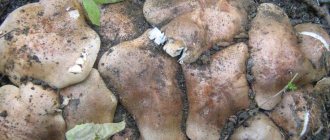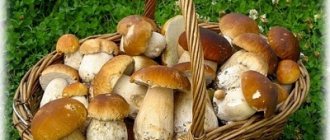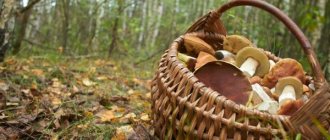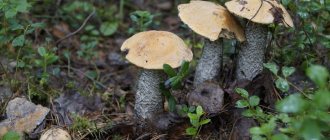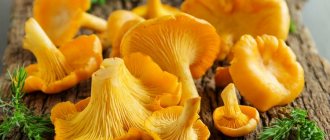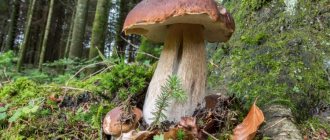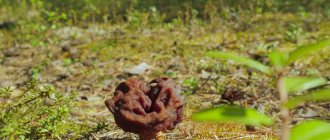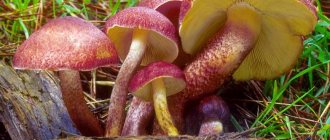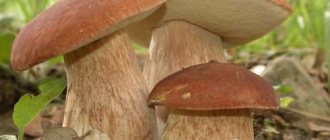Mushrooms
1
1497
Article rating
Kira Stoletova
Before the “silent hunt” you should definitely think through your route. Every forest has mushroom places, and there are edges where mushrooms are extremely rare. You also need to know that each mushroom grows in a specific type of area.
Mushroom places
Mushroom picking
Where is the best place to pick mushrooms at a certain time of year or weather? If the summer is humid and rainy, then it is better to go for mushrooms to elevated, dry places that receive a lot of sun.
They can grow away from trees, so clearings and edges are the best place for quiet hunting in such weather. When the summer is hot, you should look for mushrooms in shady places; they can grow under trees and on slopes.
The picked mushroom should be placed in a collection container (bucket or basket) with the cap facing down. Mushrooms with long legs are placed on their sides; they must first be cleaned of moss, dirt and various contaminants.
The most important rule of any mushroom picker is that you cannot take a mushroom that you doubt. A poisonous mushroom has a foreign odor, which differs from the smell of an edible mushroom.
Take valuable ones
A mycelium is a sponge that absorbs all the nastiness from the environment.
“In most edible mushrooms, the mycelium is located near the soil surface and absorbs a large amount of moisture from the environment,” explains Candidate of Pharmaceutical Sciences Igor Sokolsky . “If the soil is contaminated with water-soluble xenobiotics, they easily penetrate the mushrooms and can accumulate in quantities that render edible mushrooms inedible.”
Autumn mushrooms are the safest and healthiest. The mycelium “gives out” all the accumulated negativity with the first harvest; late autumn mushrooms can be collected safely. They are the safest. Exceptions are mushrooms collected along highways, railroad tracks, landfills, landfills, etc. Eating them is extremely dangerous.
Another important mushroom nuance is edibility. Unlike other products, mushrooms are conditionally edible. By the way, this term has taken root exclusively in our country. All over the world, sow mushrooms, volushki, russula, lacticaria, morels, milk mushrooms, rows (and other mushrooms that have a poisonous or acrid taste in their raw form) are considered inedible.
- The toxins of conditionally edible mushrooms are resistant to heat treatment (that is, neither frying nor boiling can neutralize them), - explains Elena Tereshina, Doctor of Biological Sciences , - you can eat them (if you really want) only in salted form and exclusively at a “young age” (that is, rotten wormy mushrooms - overgrown ones should be left in the forest “bed”).
Mushrooms of the first and second nutritional value - porcini, boletus, boletus, saffron milk caps, chanterelles - are not only tasty, but also extremely nutritious. They are rich in vegetable protein (dishes made from them are recommended for fasting), carbohydrates and minerals.
Dangerous mushrooms. How not to get poisoned by the gifts of the forest? More details
Mushroom picking time
To know when and where to collect porcini mushrooms, you need to know some natural features, based on the weather.
- Early spring with above-zero temperatures is the right time to collect. Morels can be found during this time period.
- During May thunderstorms and rains, you can go for boletus.
- To avoid wormy mushrooms, collection is carried out during the flowering period of the linden tree.
- In cool weather, the first chanterelles appear, this is a sign that the porcini mushroom, which is loved by all mushroom pickers, will soon begin to appear. The white mushroom also appears immediately after the first fly agarics grow.
- Clouds of midges are the main sign of humidity and a large abundance of mushrooms.
- The abundance of fluttering butterflies also indicates a high mushroom harvest.
- With the active fall of leaves in the fall, honey mushrooms begin to grow.
- The first snow may hide winter mushrooms.
Knowing where mushrooms are currently being collected, you can get exactly those types of mushrooms that grow in a certain period of time.
Greenweed
A perennial herbaceous plant growing up to 60 cm. Found in fir-spruce and coniferous-deciduous forests. Many parts of the plant are pubescent. Flowering shoots are erect, wrinkled leaves are ovoid in shape, covered with white hairs on the underside. Yellow flowers are located in the axils of the upper leaves, their calyx is bell-shaped. Flowering begins in early May.
Collection of porcini mushrooms
The noble white mushroom has an amazing taste and aroma, which is why most mushroom pickers try to find them in the forest. The most ideal place for porcini mushrooms is a coniferous forest in which ferns grow abundantly.
The porcini mushroom loves to live among pines, spruces and other conifers. They can hide in fern thickets, so you need to look for them very carefully so as not to accidentally step on a mushroom.
They grow throughout the summer and until mid-September, and their frequent companions are fly agarics and anthills. The best weather to find them is warm and humid, and they like to hide in the most secluded corners.
Male shieldweed
A forest fern with a short and thick rhizome, at the top of which there is a rosette of large leaves. Its lanceolate fronds can reach a length of one and a half meters, leaf petioles are covered with brown scales. On the underside of the leaf blade there are sori located in 2 rows. The fern spores until the end of August; the average age of the plant exceeds 30 years.
Places for collecting mushrooms
Before you go on a quiet hunt, it is best to ask mushroom pickers you know about where mushrooms grow, or look for the answer to this question on the Internet. Mushrooms regularly appear in the same places; in a short period, a large mushroom family can grow in one such clearing.
Mushrooms should not be collected in dirty places - near roads and highways, as well as near polluted rivers. You should not pick boletus mushrooms if they grow under other trees, as they will not have good taste; the same scheme applies to aspen boletuses.
Knowing the answer to the question - where to collect mushrooms in the forest, you can get an excellent harvest of tasty and aromatic mushrooms.
Nature blog
FOREST TRAILS
This is a nature blog. We hope that it will help you better navigate it and, perhaps, will captivate you so much that you yourself will want to be outdoors more often, in the forest! Here you will find the latest news about what is happening in Estonian forests, about flora and fauna. We will also talk about those representatives of the animal world that were captured in real time by the RMK video camera installed on the island of Saaremaa and in other places. Badgers may also be in the field of view of the camera, which was installed to monitor red deer. If you also want to see the inhabitants of the forest in real time, then we give you a hint: the best time for this is early morning or late evening, at this time forest animals are most active. Through photo and video reports, we will introduce you to nature trails, individual objects and other interesting phenomena - be they plants, animals or humans. Knowing the increased interest of Estonians in “silent hunting,” we also invited a mycologist to cooperate.
Definitely, the advice of a mushroom expert will be useful for both beginners and experienced mushroom pickers. “When should you go to the forest to pick mushrooms? Where can you find the most unusual mushrooms growing in Estonia? What should you consider when looking for mushrooms and how to leave the forest with a full basket?” - this is not a complete list of questions that we will try to answer in our blog. And, as the German writer and poet Johann Seime once noted: “From communication with nature you will get as much light as you want, and as much courage and strength , How many do you need". The writer and I agree one hundred percent, and you?
Blog is maintained
Tiit Hunt
, biologist, nature photographer
“I was born in May 1961 in Laaskhoon, on the banks of the Pedja River. In 1985 he completed his master's degree at Tartu State University. Biologist.
After university, he worked in Lahemaa National Park until 1990, then for six years he was an editor in the biology and medicine section of the magazine “Horizont”, and from 1996-2013 he was the head of the zoology department of the Estonian Museum of Natural History.
A love for nature and its photography was instilled in me from an early age by my father, who was a forester.
Since 1997, I have been leading the annual nature photography project “Bloodless Hunt”.
Over the years I have published several books:
“Eestimaa. Looduse teejuht” (“Estonia. Guide to nature”), “Kunst” 2005. “Väike kalaraamat: Eesti 40 tuntud ja vähem tuntud kala” (“Small fish guide: 40 famous and little-known fish of Estonia”), Maalehe raamat 2007. “ Eesti kalad” (“Fishes of Estonia”), “Varrak” 2012.”
Oleg Tsymbarevich,
naturalist and amateur photographer
“It often happens that a person lives quite successfully and nevertheless still constantly thinks and wonders what his main purpose is, and when he finally finds out (if he finds out!), he is very surprised that the answer was obvious from the very beginning . My example is just from this series. I graduated from TPI in 1979 with a degree in economics. He worked in the Ministry of Finance for many years, then, starting in the 90s, he was engaged in auditing activities. I was born in Siberia in a village surrounded by the most beautiful taiga - from there, from childhood, my love for the forest and nature in general began. Always at the first opportunity after work, I ran into the forest until I finally ran away, fortunately, realizing my main purpose.
From his youth he was interested in photography. And in recent years, hiking in the forest, nature photography and writing on natural topics in blogs and magazines have turned from a hobby into a way of life. Absolutely everything in the forest attracts me, but mushroom picking and bird watching are of particular interest. Based on the accumulated photographic material, he published three books: about mushrooms and lichens, about the swamps of Estonia, and about birds in the city. I run a blog-magazine “Notes of a Naturalist” on the Internet. For the last two years, I have been actively participating in RMK’s educational programs as a nature guide on forest study trails.”
Anatoly Tarasov
, mycologist “To begin with, I’ll briefly introduce myself: I was born, raised and still, to my great joy, live in Estonia, in an unusually beautiful and naturally diverse part of it - Ida-Viru County. In the north there is a coast with a majestic cliff “near the gray plain of the sea”, in the south there is a pearl - Lake Peipsi, in the east there is the beautiful Narova with stormy waters, in the center there is a network of delightfully beautiful Kurtna lakes hidden among pine forests. I have been picking mushrooms for over fifty years, as they say, “from a young age.” I’ve been to many parts of Estonia, but I must say, and don’t let residents of other places be offended by me: Ida-Viru County is beyond competition. This is the mushroom kingdom of Estonia!
Mining engineer by training. Graduated from Tallinn Polytechnic Institute. He was involved in hockey, clay pigeon shooting, music and much more. Member of the St. Petersburg Mycological Society. It seems that today its only representative is from Estonia. Together with my colleague Irina Aleksandrovna Ukhanova from Stavropol, we have been publishing the first Russian magazine about mushrooms and for mushroom pickers, “Mushroom Picker of Russia,” for the fourth year now. On the page, my goal is to inform both beginners and experienced mushroom pickers, as far as possible, about the current mushroom situation in the forests, to introduce mushrooms as they appear, both well-known, rare, and poisonous. I’ll tell you about their properties, features, cooking methods and much more.
Good luck to all mushroom pickers in the coming season and... stay tuned for new “arrivals” on our blog!
PROTECTION OF NATURE
One of RMK's areas of activity is nature conservation, the goal of which is to preserve the natural diversity of state lands. To do this, it is necessary to carry out the necessary work to protect nature and follow the most important principles of maintaining diversity in economic forests. Specialists of the Nature Conservation Department organize the restoration of biotopes of endangered or poor-condition species, care for the biocenosis and its restoration, care of parks and individual objects, as well as marking of protected zones. Department specialists share information about the progress of work at some sites on the pages of our blog about nature in the NATURE CONSERVATION section.
The best time for a "silent hunt"
The most practical advice that experienced mushroom pickers can give is to go for mushrooms early in the morning. In this case, there are many chances to collect a full basket, since the mushrooms shine with dew and are very clearly visible.
Chanterelles are also brightly colored, so they are easy to spot among greenery and pine needles. It is best to take a long stick with you, with which you can move the foliage aside, looking into secluded corners.
The most ideal container for collecting is a basket, since it has holes, thanks to which excess moisture evaporates from the basket and the mushrooms are preserved much better and longer.
Siberian cedar pine
An evergreen tree typical of dark coniferous taiga. It grows up to 44 m, the trunk diameter reaches 2 m. Life expectancy can exceed 500 years. The tree has a straight, even trunk, a dense crown, soft, bluish needles and large, ovoid cones filled with seeds - pine “nuts”. There can be up to 150 of them in each cone. In one season, a tree can produce about 12 kg of “nuts”.
What not to do?
- The most important rule is do not take a mushroom if you are not sure about it.
- You can't go too far into an unfamiliar forest.
- Mushrooms that have just grown and are still strong should not be touched.
- You cannot pull out mushrooms; they need to be twisted out of the mycelium so as not to damage it.
How to cook and store chanterelles?
Chanterelles are boiled, fried, salted, pickled, dried
.
Boil chanterelles
within 15-20 minutes after boiling. If you eat chanterelles after cooking, add salt to the water. If you fry after cooking, you do not need to add salt and the cooking process in this case will not last longer than 5 minutes.
Wash the dried chanterelles and soak them in warm water for 2-4 hours before cooking. Then cook in the same water for 40 minutes.
Chanterelles are fried
without boiling, but if the chanterelles are bitter, then you need to boil them.
Slice the mushrooms before frying. First, fry finely chopped onion in oil in a frying pan, then add the chanterelles. Fry the mushrooms until all the moisture has evaporated. Then add salt to taste, add sour cream and simmer until tender for 15 minutes.
Chanterelles are salted cold and hot.
Marinated chanterelles are prepared with and without pasteurization.
Marinated chanterelles with pasteurization
Thoroughly clean and wash the mushrooms, chop large ones and cook for 15 minutes in salted water with the addition of citric acid.
Place the prepared chanterelles in clean jars and pour the hot marinade over them, adding onion rings and bay leaves on top. Cover the jars with lids and pasteurize for 2 minutes. Then immediately roll up the lids and store in a dry place with a temperature of 0 to 15 degrees.
Drying chanterelles
on a drying board or a special dryer, the mushrooms should not touch each other. Before drying, mushrooms are not washed, but they are cleaned of dirt with a brush if large ones are cut into several pieces.
The rooms in which chanterelles are dried should be well ventilated. Can be dried outside in the shade.
If drying in a stove or oven, first the temperature should be 60-65 degrees, and then higher.
Store dried chanterelles in glass or plastic containers with tight-fitting lids.
Return to contents
Useful tips
As already mentioned, mushrooms should be picked early in the morning, as they are much easier to spot before the bright sun appears. There is no need to rush, it is important to look under all the leaves, bushes and trees.
If you find a mushroom, then its family may be located very close by; it’s worth taking a look around this place. Old mushrooms should not be picked, as they release harmful substances; small mushrooms also should not be touched.
Knowing where chanterelle mushrooms are collected, you can return with an excellent harvest. These are wet places, near rivers and lakes, this is where you can collect a lot of chanterelles.
These mushrooms are perfectly stored and do not break during transportation, being very elastic. The mushroom harvest must be immediately processed, washed, peeled and sent for cooking, drying or pickling.
blue cyanosis
Herbaceous perennial, growing up to 1.4 m. Distributed in forest-steppe and forest zones, growing alone or in small groups. It has straight, hollow stems, odd-pinnate, bare leaves, bluish or purple, less often white flowers. Flowering occurs in June-July. The rhizome with the roots of the plant is used as a medicinal raw material.
Photos of the best places to pick mushrooms
Kinds
Conical or long . _ The upper part measures no more than 5*10 cm. On the cap, the dark-colored cells acquire a brown tint. The mushroom is intact, the cap is fused with the stem. It reaches a height of 10 cm. The leg is often covered with a powdery coating and the shape is uneven. The fruit body is tender, with a nutty, mushroom smell.
Conical morel
Ordinary . The upper part is in the form of an egg up to 12 cm high. There are voids inside, and on the surface there are holes and thin partitions. The hollow leg expands downwards up to 15 cm. It is covered with plaque. There are no lamellar bridges, the cap is fused.
The morel is real.
Semi-free . Differs from the representatives described above. A small mushroom in the shape of a cone narrows strongly towards the top. It has a dark color, the surface consists of folds and cells. The headband separates the cap from the stem. The height of the top of the mushroom is up to 4 cm. The stem has a yellowish tint or is white.
The morel is semi-free.
Stitches and morels
All real morels are edible, but they can be confused with their dangerous “double” - string .
String has the ability to accumulate and change the concentration of a toxic substance depending on environmental conditions. The greatest toxicity is observed in dry spring. The mushroom contains a poison called gyromitrin. It does not collapse even after prolonged heat treatment.
Strings are constantly confused with morels, which can result in negative health consequences. But they differ in appearance. You just need to take a good look. The stitching is squat and chunky. Its cap is practically adjacent to the soil, and its leg is barely noticeable. Morels are tall, slender, stretching upward. The stem and fruiting body are entire, but can be examined separately.
Autumn line.
Industrial use of forests
The forest is an invaluable wealth that, in addition to food and oxygen, provides humans with wood. In Russia, special industries have been created and are developing that are engaged in the procurement and processing of forest materials. Different types of activities are performed by workers involved in the forest industry:
- timber harvesting;
- wood processing and production of furniture, lumber, wood blocks, matches, etc.;
- production of pulp, cardboard and paper;
- production of charcoal, fuel briquettes.
Timber harvesting in the taiga
Industrial forests in Russia include those areas where trees suitable for felling grow. It is very sad that in addition to industrial deforestation, poaching is often carried out, which causes irreparable harm to the environment and local residents. Forest areas very often suffer from enterprises that are located nearby and emit harmful chemical elements into the air from their chimneys. Serious problems arise from industrial pollution of forests. Plants and animals die, soil and air are polluted. Logging belongs to the logging industry and is controlled by state forestry logging enterprises.
